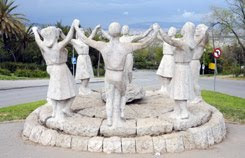Many visitors to Barcelona are struck by the quality and quantity of its outdoor sculpture. As you wander around, you may think that nearly every square, park or boulevard boasts a striking piece of artwork. And you are right.
As part of the regeneration process for the 1992 Olympic Games, Barcelona’s city council acquired a sizable collection of sculpture from local and international artists. It was part of the criteria of giving the city a much-needed facelift without causing major structural changes. A nd it worked! These bright, thought-provoking elements have become as much a feature of Barcelona’s urban landscape as its 19th century architecture.
nd it worked! These bright, thought-provoking elements have become as much a feature of Barcelona’s urban landscape as its 19th century architecture.
Perhaps the most famous work of public art in the city is the ‘Barcelona Head’, a vivid, cartoon-like face by the late trailblazer of the Pop Art movement Roy Lichtenstein (it lives in front of Port Vell marina). In front of the Ciutadella Park, Antoni Tapiés, Catalunya’s greatest living artist, pays homage to Picasso with a thought-provoking composition of copper, glass and water.
Up in the park of Montjuïc, a group of girls performing the sardana (Catalunya’s national dance) have appeared in countless holiday snaps. Over on the Rambla del Raval, a rotund, copper cat by Columbian artist Fernando Botero has become a landmark and meeting place on this popular boulevard. Another piece of art that serves this purpose is Rebecca Horn’s ‘Homenaje a Barceloneta’. Consisting of four, stacked metal cubes, the work is inspired by the box- like chiringuitos (or beach bars) that used to line this part of the coast, and were bulldozed to make way for the sand that the sculpture now stands on.
As part of the regeneration process for the 1992 Olympic Games, Barcelona’s city council acquired a sizable collection of sculpture from local and international artists. It was part of the criteria of giving the city a much-needed facelift without causing major structural changes. A
 nd it worked! These bright, thought-provoking elements have become as much a feature of Barcelona’s urban landscape as its 19th century architecture.
nd it worked! These bright, thought-provoking elements have become as much a feature of Barcelona’s urban landscape as its 19th century architecture.Perhaps the most famous work of public art in the city is the ‘Barcelona Head’, a vivid, cartoon-like face by the late trailblazer of the Pop Art movement Roy Lichtenstein (it lives in front of Port Vell marina). In front of the Ciutadella Park, Antoni Tapiés, Catalunya’s greatest living artist, pays homage to Picasso with a thought-provoking composition of copper, glass and water.
Up in the park of Montjuïc, a group of girls performing the sardana (Catalunya’s national dance) have appeared in countless holiday snaps. Over on the Rambla del Raval, a rotund, copper cat by Columbian artist Fernando Botero has become a landmark and meeting place on this popular boulevard. Another piece of art that serves this purpose is Rebecca Horn’s ‘Homenaje a Barceloneta’. Consisting of four, stacked metal cubes, the work is inspired by the box- like chiringuitos (or beach bars) that used to line this part of the coast, and were bulldozed to make way for the sand that the sculpture now stands on.
No comments:
Post a Comment